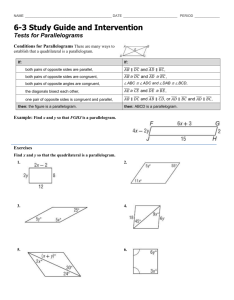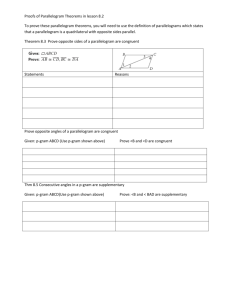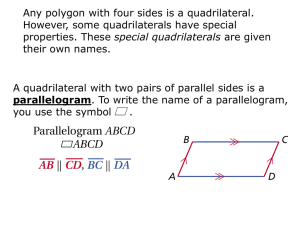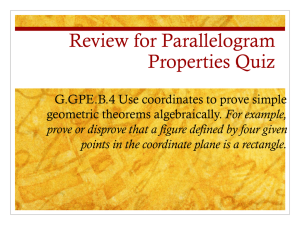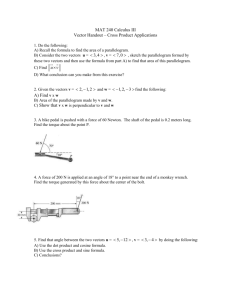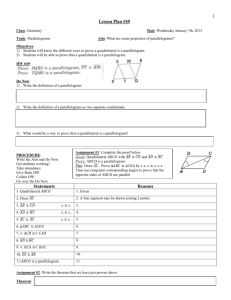Tests for Parallelograms
advertisement
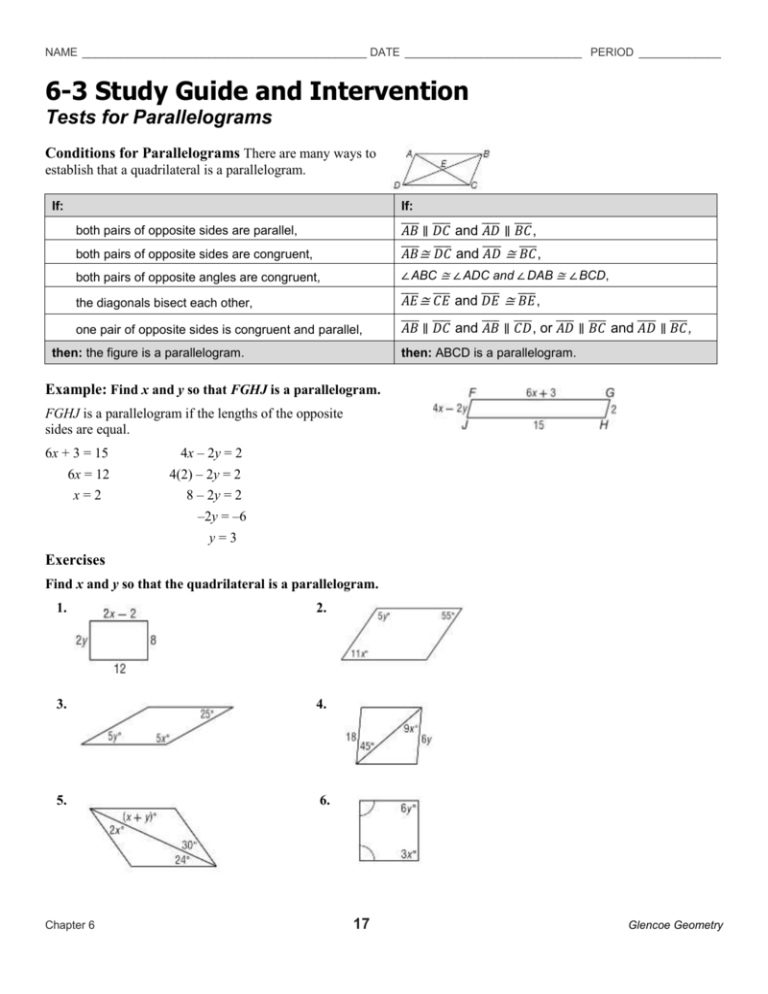
NAME _____________________________________________ DATE ____________________________ PERIOD _____________ 6-3 Study Guide and Intervention Tests for Parallelograms Conditions for Parallelograms There are many ways to establish that a quadrilateral is a parallelogram. If: If: both pairs of opposite sides are congruent, ̅̅̅̅ 𝐴𝐵 ∥ ̅̅̅̅ 𝐷𝐶 and ̅̅̅̅ 𝐴𝐷 ∥ ̅̅̅̅ 𝐵𝐶 , ̅̅̅̅≅ 𝐷𝐶 ̅̅̅̅ and 𝐴𝐷 ̅̅̅̅ ≅ 𝐵𝐶 ̅̅̅̅ , 𝐴𝐵 both pairs of opposite angles are congruent, ∠ ABC ≅ ∠ ADC and ∠ DAB ≅ ∠ BCD, the diagonals bisect each other, ̅̅̅̅ 𝐴𝐸 ≅ ̅̅̅̅ 𝐶𝐸 and ̅̅̅̅ 𝐷𝐸 ≅ ̅̅̅̅ 𝐵𝐸 , one pair of opposite sides is congruent and parallel, ̅̅̅̅ ∥ 𝐷𝐶 ̅̅̅̅ and 𝐴𝐵 ̅̅̅̅ ∥ 𝐶𝐷 ̅̅̅̅, or 𝐴𝐷 ̅̅̅̅ ∥ 𝐵𝐶 ̅̅̅̅ and 𝐴𝐷 ̅̅̅̅ ∥ 𝐵𝐶 ̅̅̅̅ , 𝐴𝐵 both pairs of opposite sides are parallel, then: the figure is a parallelogram. then: ABCD is a parallelogram. Example: Find x and y so that FGHJ is a parallelogram. FGHJ is a parallelogram if the lengths of the opposite sides are equal. 6x + 3 = 15 4x – 2y = 2 6x = 12 4(2) – 2y = 2 x=2 8 – 2y = 2 –2y = –6 y=3 Exercises Find x and y so that the quadrilateral is a parallelogram. 1. 2. 3. 4. 5. 6. Chapter 6 17 Glencoe Geometry NAME _____________________________________________ DATE ____________________________ PERIOD _____________ 6-3 Study Guide and Intervention (continued) Tests for Parallelograms Parallelograms on the Coordinate Plane On the coordinate plane, the Distance, Slope, and Midpoint Formulas can be used to test if a quadrilateral is a parallelogram. Example: Determine whether ABCD is a parallelogram. The vertices are A(–2, 3), B(3, 2), C(2, –1), and D(–3, 0). 𝑦 −𝑦 Method 1: Use the Slope Formula, m = 𝑥2 − 𝑥1. 2 1 3−0 3 2 − (−1) 3 slope of ̅̅̅̅ 𝐴𝐷 = −2 − (−3) = 1 = 3 slope of ̅̅̅̅ 𝐵𝐶 = 3 − 2 = 1 = 3 ̅̅̅̅ = slope of 𝐴𝐵 2−3 3 − (−2) = 1 5 ̅̅̅̅ = slope of 𝐶𝐷 −1 − 0 2 − (−3) =– 1 5 ̅̅̅̅ || 𝐶𝐷 ̅̅̅̅ and 𝐴𝐷 ̅̅̅̅ || 𝐵𝐶 ̅̅̅̅ . Therefore, ABCD is a parallelogram by definition. Since opposite sides have the same slope, 𝐴𝐵 Method 2: Use the Distance Formula, d = √( 𝑥2 − 𝑥1 )2 + ( 𝑦2 − 𝑦1 )2 . AB = √(−2 − 3)2 + (3 − 2)2 = √25 + 1 or √26 CD = √(−2 − (−3))2 + (−1 − 0)2 = √25 + 1 or √26 AD = √(−2 − (−3))2 + (3 − 0)2 = √1 + 9 or √10 BC = √(3 − 2)2 + (2 − (−1))2 = √1 + 9 or √10 ̅̅̅̅ ≅ 𝐶𝐷 ̅̅̅̅ and 𝐴𝐷 ̅̅̅̅ ≅ 𝐵𝐶 ̅̅̅̅ . Therefore, ABCD is a parallelogram by Since both pairs of opposite sides have the same length, 𝐴𝐵 Theorem 6.9. Exercises Graph each quadrilateral with the given vertices. Determine whether the figure is a parallelogram. Justify your answer with the method indicated. 1. A(0, 0), B(1, 3), C(5, 3), D(4, 0); Slope Formula 2. D(–1, 1), E(2, 4), F(6, 4), G(3, 1); Slope Formula 3. R(–1, 0), S(3, 0), T(2, -3), U(–3, –2); Distance Formula 4. A(–3, 2), B(-1, 4), C(2, 1), D(0, –1); Distance and Slope Formulas 5. S(–2, 4), T(–1, –1), U(3, –4), V(2, 1); Distance and Slope Formulas 6. F(3, 3), G(1, 2), H(–3, 1), I(–1, 4); Midpoint Formula 7. A parallelogram has vertices R(–2, –1), S(2, 1), and T(0, –3). Find all possible coordinates for the fourth vertex. Chapter 6 18 Glencoe Geometry
